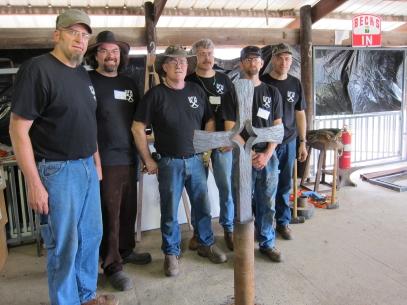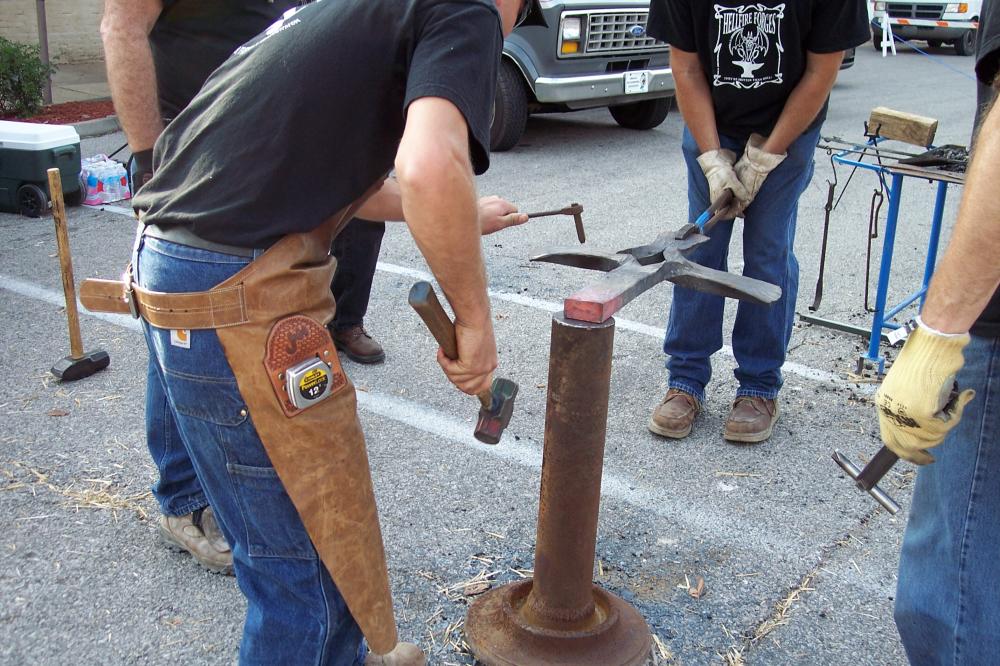
ptree
Members-
Posts
774 -
Joined
-
Last visited
-
FrankOfNoTrades started following ptree
-
Wish you be too Thomas. An aloha shirt would add to the eclectic mix.
-
Having designed and built presses in industry to 100 tons, and worked on many to 2400 tons, including in forge shops may I offer a little safety insight? First in hydraulics, it is not a question of if there will be a leak but when and how bad. As Frosty notes encase those flex lines. Use the least number of flex lines possible. Use seamless pipe if using pipe. DO NOT USE hardware store cast iron fittings. For more pressure than 150 psi go with the class rated forged fittings, ie for 1000 psi buy class 1000 fittings. Get the pipe schedule that matches. Put a nice big fire extinguisher right inside the exit door, hung right underneath the cutoff switch for the press that you thoughtfully ran there. Why? So you can do the smart thing and GET OUT of the building, turn off the press from outside by reaching in, and while standing outside, in clean air make the decision, small enough to fight or oh shucks lets call 911.
-
the Meteorite Mashers will be meeting in my shop, in Floyds Knobs Indiana, very very close to you on the Saturday after Thanksgiving for the "Smoked Turkey Hammer-in" a meeting for which I hickory smoke several turkeys for the lunch entree. PM me, I am often in the shop on Sundays.
-
NEVER EVER use a regular shop compressor to supply breathing air. Oil in the compressor can and OFTEN does combust, poorly, make carbon monoxide. You will then go to sleep, and maybe permanently. The seal line on most masks is along the ridge of the jaw. Facial hair will prevent a seal. greasing down the hair will improve the seal, but not perfect the seal. How much of the stuff outside the mask do you care to breath? OSHA always requires that engineering controls be used first. Simply said, remove the threat BEFORE it reaches the worker. So local exhaust would be the first choice. A 125 foot per minute movement of air across the point of generation into an exhaust duct will capture the threat smoke, fume etc. Now as we have long ago learned with coal smoke the farther away the exhaust pipe is the more air has to flow to capture the smoke. Put a 1" duct right at the MIG gun nozzle, and the mig fume is GONE. These are production items, used in factories. They work. Grinding? use a duct right under the wheel/belt. The particles are already moving in the right direction. Put a flip over door on the duct and one small fan can suck the dust up from many points as only one needs that magic 125FPM. How big a fan you ask? do a little math, a 4" by 4" duct opening has 16 square inches and 16 divided by 144= .11 that .11 times 125 = 13.88 CFM fan if all friction in the duct is ignored. I would happily use a small say 20cfm blower rated for suction. I would run that duct into the center of a 5 gallon bucket with 1/4 fill of water. The duct would enter vertically down and stop about 3/8 to 1/2" above the water. I would have an exit to the blower from the top of the bucket. The velocity of particals downward would cause them to impact the water rather than do a 180 degree turn to exit. I would still pipe the exhaust from the blower outside, both for noise and for that odd bit that gets by the water. In effect this is a poor man's metal dust collector as has been built by many vendors for maybe 80 years. Why wear a respirator with a beard and not have it seal if you can remove the threat this way. I don't have a beard, don't grind that much but have a P-100 respirator for when I do. Weld smoke is exhausted in my shop by general ventilation via a 3500 cfm fan causing a cross flow of air across my weld table.
-
It would appear that 3M does not make the N-100 pancake filters for this respirator.
-
Thomas my friend, I am so sorry for your loss.
-
I would go with the real 3M filters. For back ground, I have over 20 years of EHS experience in metal working factories. I find the pancake style like these to be very easy to breath through. Question, if you are not in an oil mist environment as well as dusty, you know than a N-100 is less expensive? the P or N refers to Permissible or Not as far as oil mist. The N type are often half the price of the P type.
-
Sorry to hear of the health issues, I missed all of it while I was deployed to Portland Oregon for 7 weeks.
-
Designing a 50lb guided helve hammer.
ptree replied to tylerdewitt's topic in Power Hammers, Treadle Hammers, Olivers
my 70# guided helve hammer uses a compact spare tire as bot flywheel and clutch. Works very nicely. Used a 1990 Gran Caravan rear axle bearing hub assembly. It bolted to the axle and so I just unbolted the entire bering hub assembly took the spare tire and another wheel from the junker. The hub assembly bolted onto the hammer frame using the original bolts from the van. I cut the center from the second wheel and used that to weld a bottom for the pittman to and then just placed it over the compact spare. Has been running since 2005. I started at 32# and the Vee belt drive sorted of worked. Upped the ram to 45# and smelled burning rubber and it was jerky as it needed a flywheel. Went to the tire clutch. A couple of years ago I upped to 70# and changed the ram guide to mostly mirror the tire hammer slide design. -
Judson, Harrington makes really first class industrial hoists, been using them in heavy industry since 1981. They are more expensive than Jet. That said Jet is also good. The harbor freight hoists are crap. If you take their nameplate rating and cut in half, then deduct another say 15% you are probably safe.
-
What weird animals have been in your shop
ptree replied to Glenn's topic in Blacksmithing, General Discussion
I get the ground hogs, and dirt daubers as well as trapped birds. The scariest was a white tail buck, neck fat in full rut who was half way in the shop door. I turned around from the power hammer and he was about 6' away. He backed out quick when I waved the hot end of the bar in his face. talk about closing the door quick after! -
Wow that is a loud pump! sounds like it is cavitating. Are you sucking oil up from the tank? if so you may have a small air leak and that will make the noise and kill the pump. If the suction line is undersized that will also cavitate the pump.
-
Wecome, while not in Kentucky, the indiana Blacksmithing Association is very active with 13 sattalite groups across Indiana. Our group meets in Southern Indiana. If you google Indiana Blacksmithing Association you will find a satellite group page and just click on the groups closest for meeting dates and contact info. Our group, the Southern Indiana Meteorite Mashers may be the clossest to you with the Vernon group about a tie. A Saturday in a real forge with a smith to show you hands on is worth alot when you are starting out.
-
guide idea for a power hammer
ptree replied to andys MQ's topic in Power Hammers, Treadle Hammers, Olivers
If using the rod as the hammer face no. The hard chrome will not turn from Chrome 5 to chrome 6(Hexavalent chrome) at any temp seen in forging. The place where Hex chrome is evolved from plain chrome is at very high temps like in an arc weld and especially in a TIG weld as the temp is high enough and the severe ultra-violet energy as excites the chrome atoms to jump up to valance +6 As a safety guy in factorys, where extensive welding is uses I have studied this a bit:) Hex chrome is a real issue when welding stainless steel as the chrome contents in SS vari from about 13% to 18%. Most alloy steels have less than 1%. The chrome in plating is an issue if welding. The chrome plating baths themselves are a source if working around them. Hex chrome is an issue, but then all weld smoke is an issue. Coal smoke is an issue. If you are breathing, anywhere in the world, you are breathing some magnesium silicate, a mineral in the earth. Magnesium silicate is also called asbestos. If there is anything in the air you breath, beyond the normal gasses that make up our atmosphere then you are breathing in stuff that is an issue. Sooo.... avoid breathing smoke. avoid breathing dust. Remember that dust you can see in the air is usually not the issue, it is the particulate that is too small to be seen that is the most harmful. If you are healthy enough and do not have facial hair a respirator can be used to filter out most of this stuff. A N-100 filter will remove the particulate. Smoke is by the way comprised mostly of particulate. -
Breaking down an axel shaft with minimal tools
ptree replied to Patrick Kerns's topic in Blacksmithing, General Discussion
Here is a couple of photo's of the BFH team's trvel anvil, a 252# Axle forging. This is an as forged, not machined 4140 axle shaft. The flange was undersize and so scrapped. My big striking anvil looks much the same but is 454# and is taller so the flange is burried some to bring the top down to the right height. Our team has forged 9 of these big split crosses from 3" square, a couple of carved wizards from 3" square and recently a boat anchor from 2" round bar. This axle shaft anvil rings loudly. The top although not heat treated has not mushroomed under the steady assault of as many as 4 strikers, although errant blows have dented it occasionally. We have traveld to Pontiac Ill. , Tipton Indiana and Cannelton Indiana as well as Jeffersonville indiana twice to demonstrate with this anvil.

